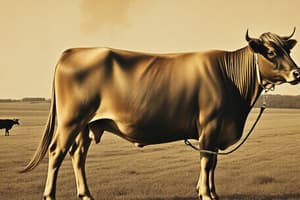Podcast
Questions and Answers
What characterizes the growth phase after the pre-embryonic phase?
What characterizes the growth phase after the pre-embryonic phase?
- Rapid development of all tissues simultaneously
- Differential growth rates of various tissues and organs (correct)
- Only external body shape changes
- Uniform slow growth of all organs
Which organs develop rapidly and reach a high degree of maturity in the early stages of life?
Which organs develop rapidly and reach a high degree of maturity in the early stages of life?
- Nervous system, heart, liver, and kidneys (correct)
- Fats
- Bones
- Muscles
What shape does the growth curve of post-embryonic growth resemble?
What shape does the growth curve of post-embryonic growth resemble?
- U-shape
- L-shape
- V-shape
- S-shape (correct)
What happens during the third stage of the post-embryonic growth curve?
What happens during the third stage of the post-embryonic growth curve?
How do the lengths of growth stages differ among species?
How do the lengths of growth stages differ among species?
During the early stages of life, which tissues develop in order of priority?
During the early stages of life, which tissues develop in order of priority?
In Stage 3 of body development for cows, which tissue type starts to grow rapidly?
In Stage 3 of body development for cows, which tissue type starts to grow rapidly?
What weight range defines Stage 2 for sheep?
What weight range defines Stage 2 for sheep?
At what stage do animals' organs and bones reach near-maturity and muscles are in a high growth phase?
At what stage do animals' organs and bones reach near-maturity and muscles are in a high growth phase?
Which of these animals reaches a body weight range of 0.68-2.27 kg in the second growth stage?
Which of these animals reaches a body weight range of 0.68-2.27 kg in the second growth stage?
Flashcards are hidden until you start studying




